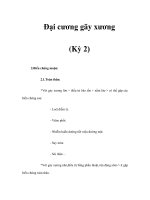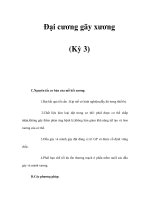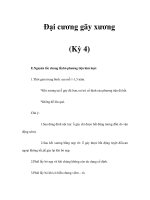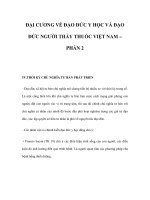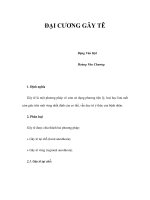Đại cương gãy xương CLB Y Khoa Trẻ ĐH Y Khoa Vinh
Bạn đang xem bản rút gọn của tài liệu. Xem và tải ngay bản đầy đủ của tài liệu tại đây (2.26 MB, 48 trang )
Bs CKI.CTCH.Trần Văn Thuyên
Trưởng Khoa CTCH
Phone:0983969491
Mail:
Page Facebook:Bs Thuyên Chấn thương chỉnh hình - cơ xương khớp bv
Quốc tế Vinh
Đại cương gãy xương
11/29/18
Ví dụ: Hình ảnh đã thay slide 1
11/29/18
•
An orthopaedic surgeon dealing with trauma must combine the knowledge of the
systemic effects of trauma, including immunological impair-ment, malnutrition,
pulmonary and gastrointestinal dysfunc-tion, and neurological injury in planning
both the timing and the type of surgical intervention required.
•
The goal of fracture treatment is to obtain union of the fracture in the most
anatomical position compatible with maximal functional return of the extremity
CLASSIFICATION OF FRACTURES
•
•
The extensive Orthopaedic Trauma Association (OTA) classification
•
The latest 2007 update of the OTA classification includes the AO classification
Name: such as Judet, Judet, and Letournel’s classification of acetabular fractures
and Neer’s classification of proximal humeral injuries.
Linear
Comminuted
Segmental
Bone Loss
Modes of bone healing
•
primary bone healing (strain is < 2%)
– intramembranous healing
•
occurs via Haversian remodeling
– occurs with absolute stability constructs
•
secondary bone healing (strain is between 2%-10%)
– involves responses in the periosteum and external sof tissues.
•
•
enchondral healing
– occurs with non-rigid fixation, as fracture braces, external fixation, bridge plating, intramedullary nailing,
etc.
bone healing may occur as a combination of the above two process depending on the
stability throughout the construct
Type of Fracture Healing with Treatment Technique
Cast treatment
Secondary: enchondral ossification
External fixation
Secondary: enchondral ossification
IM nailing
Secondary: enchondral ossification
Compression plate
Primary: Haversian remodeling
CLASSIFICATION OF SOFT TISSUE INJURIES
Gustilo and Ander-son in 1976
•
•
•
Type I open fractures have a clean wound less than 1 cm long.
In type II wounds the laceration is more than 1 cm long but is without extensive
sof tissue damage, skin flaps, or avulsions.
Type IIIA open fractures have extensive sof tissue lacera-tions or flaps but
maintain adequate sof tissue coverage of bone, or they result from high-energy
trauma regardless of the size of the wound. This group includes segmental or
severely comminuted fractures, even those with 1-cm lacerations.
•
•
Type IIIB open fractures have extensive sof tissue loss with periosteal stripping
and bone exposure. They usually are massively contaminated.
Type IIIC open fractures include open fractures with an arterial injury that
requires repair regardless of the size of the sof tissue wound
•
Other classifications include that of Tscherne and Gotzen, which is widely used in
Europe. Closed fractures are divided into grades 0 through 3 (Fig. 53-3). Open
fractures are divided into grades 1 through 4 (Table 53-2)
Open Fractures (OTA 2010)
Evaluation is based on the mnemonic ABCDE
•
•
Airway, which should be free and unobstructed
•
Circulation both central and peripheral; the goal is good capillary filling of all
extremities and maintenance of a normal blood pressure
•
•
Breathing, which should be as normal as possible under the circumstances with
normal oxygenation
Disability, which includes neurological, musculoskeletal, uro-logical, and reproductive
injuries. These injuries, although rarely life threatening, can result in serious longterm disability.
Environment. Many of these injuries do not occur in an iso-lated situation and may
result in contamination that can expose caregivers to disease.
•
•
•
•
Life- and limb-threatening musculoskeletal problems include hemor-rhage from
wounds and fractures,
infections from open frac-tures,
limb loss from vascular damage and compartment syndrome, and
loss of function from spinal or peripheral neurological injuries.
OPEN FRACTURES
•
Tscherne described four eras of open fracture treatment: life preservation,
limbpreservation, infection avoidance, and functional preserva-tion.
AMPUTATION VERSUS LIMB SALVAGE
•
The development of sophisticated protocols for open fracture management has
permitted the development of techniques that result in salvaged but nonfunctional
extremities. There is concern, however, about “technique over reason” and not
only the end result of a useless limb but also the physical, psychological, financial,
and social effects on the individual
Mangled Extremity Severity Score
The Mangled Extremity Severity Score
(MESS)
•
Some studies have found that limbs with scores of 7 to 12 ultimately required
amputation, whereas scores of 3 to 6 resulted in viable limbs.


